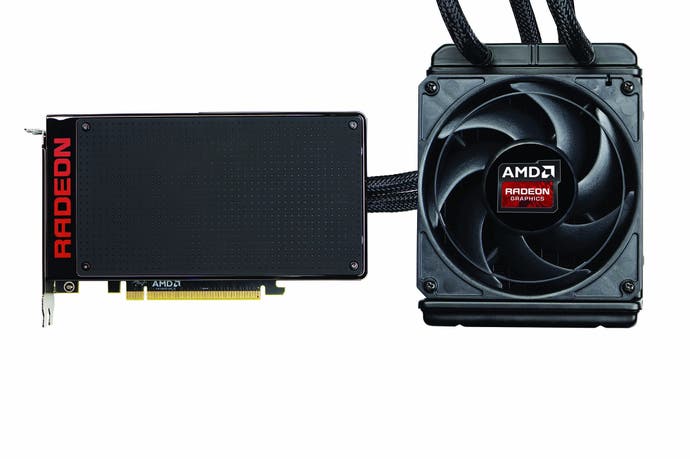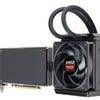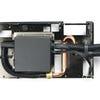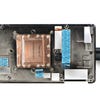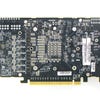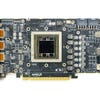AMD Radeon R9 Fury X review
The fast and the furious.
AMD is leading us into a new, exciting era of graphics technology - where ultra-fast memory is connected directly to the core, enabling higher performance, enhanced power efficiency and a new wave of small form-factor graphics cards. The Radeon R9 Fury X is the first GPU to arrive boasting this cutting-edge tech, with AMD telling us that it is the fastest single-chip GPU on the market, a title currently held by Nvidia's mammoth Titan X 12GB. Well, the reality is that the Fury X is a fascinating first-gen product with plenty of positives, but in terms of raw performance, both Nvidia's Titan X and its cut-down GTX 980 Ti are generally faster and more versatile for the high-end enthusiast market.
As always, performance is king, so AMD's inability to be comprehensively competitive with Nvidia's GM200 across the length and breadth of our benchmarks is a little disappointing - but certainly in terms of the physical package, it's great to see that the poor reference cooling design of the 200 series is now a thing of the past. The Fury X is built from quality materials that look good and even feel good, and the dinky, compact nature of the 7.5-inch board is quite remarkable - it's a marvel of integration. The work AMD carried out on the Radeon R9 295X2's reference water cooler is carried over and refined on Fury X, which also has its own closed-loop set-up that is significantly quieter than Nvidia's reference coolers, though it is accompanied by a continuous, consistent, high-pitched tone - presumably emanating from the pump. It was a little bothersome on the test bench, but will hopefully be less of an issue when the card is installed deep within a decent case.
Comparisons with decent aftermarket coolers are interesting though - the fan mounted onto the radiator isn't silent when it's really being pushed and the overall package isn't that much quieter than the MSI cooler we saw recently on the R9 390X. The difference comes down to the fact that the radiator is mounted on the case where it can directly push heat out of the chassis - something the fancy third-party coolers rely upon case airflow to achieve.
The aesthetics are finished off with a red LED Radeon logo, along with a series of lights designed to give some rudimentary measurement of GPU load. Other features include a dual-BIOS switch (there are two BIOSes, one of which you can re-write), while power is supplied via two eight-pin inputs fed from your PSU. Display outputs consist of three DisplayPorts, along with HDMI 1.4a video. The end of the DVI port is nigh, it seems.
- Order the Radeon R9 Fury X from Amazon with free shipping
This is usually the part of the review where we get some idea of a new GPU's capabilities by running it through our Crysis 3 gameplay test - where we attempt to run the game at a display's native resolution and as close to its refresh rate as possible: 60Hz. Which brings up an interesting point - Fury X is seemingly targeted at 4K gamers, but the reality is that the latest top-tier GPUs are much more suited to 1440p gameplay with all the visual trimmings. And this presents a slight issue: as you'll see later on this review, Fury X really is at its best - and at its most competitive - at UHD. Our solution? To carry out the Crysis test at both 1440p and 4K on both Fury X and GTX 980 Ti, so it's lucky that our brand new 4K, 60Hz DisplayPort 1.2 capture solution came online just in time for the occasion.
It is worth bearing in mind that 4K is a 4x increment in pixel count over 1080p, and a 2.25x boost over 1440p. Driving that sort of resolution on top-end quality settings is fool's errand: something has to give, so at UHD we drop down from Crysis 3's very high quality preset to high. Suffice to say that it reduces GPU overhead massively. As is often the case when ultra settings are dropped down just one notch, there's only a limited impact on image quality, and that's mostly unseen in the thick of the action. To add some spice to the proceedings, we also add the GTX 980 Ti to the mix, operating at exactly the same settings.
The end result? Well, 60fps can't be sustained at either of our quality setting/resolution combos but it's clear that it's the GTX 980 Ti that gets closer to the target. We'd need to drop down to medium to sustain something closer to 60fps at 4K, which strongly suggests to us that even the latest 'uber' GPUs don't have the plumbing to drive UHD displays with gameplay fast enough to match the typical 60Hz refresh.
| Crysis 3 V-Sync Gameplay | R9 Fury X 1440p | GTX 980 Ti 1440p | R9 Fury X 4K | GTX 980 Ti 4K |
|---|---|---|---|---|
| Lowest Frame-Rate | 40.0fps | 44.0fps | 28.0fps | 30.0fps |
| Dropped Frames (from 18650 total) | 1141 (6.12%) | 624 (3.35%) | 5320 (28.53%) | 3626 (19.44%) |
Order the graphics cards tested against the R9 390 from Amazon, with free shipping:
- Radeon R9 390X 8GB
- Radeon R9 Fury X 4GB
- GeForce GTX 980 4GB
- GeForce GTX 980 Ti 6GB
- Nvidia Titan X 12GB
But this is just one game, one experience. To get an idea of what Fury X is capable of across more modern titles, it's time to break out the benchmarks, based on the Fury X paired with a Core i7 4790K system overclocked to 4.6GHz, matched with 16GB of 1600MHz DDR3 and running from a Crucial SSD. We usually start our tests at 1080p and scale up from there, but starting at 4K is perhaps the more logical approach - and it's certainly where AMD is most competitive. Similar to the Crysis 4K gameplay test, we knock down all games by one 'notch' from maximum, in an attempt to remove the worst of the diminishing returns found on ultra-level settings.
Out of the nine games, AMD musters four wins over the 980 Ti. Three of them - Ryse, Far Cry and Shadow of Mordor - aren't really that much of a surprise. These titles always seem to run faster on AMD's hardware (the result, we suspect, of console GCN optimisations feeding through to PC GCN hardware). Titles like The Witcher 3 and Call of Duty only show a small advantage to Nvidia, but Battlefield 4 sees the 980 Ti storm ahead, dominating by over 19 per cent - the biggest margin of the lot.
However, once overclocking is factored in, the GTX 980 Ti is back in the game on all of our test games, increasing its lead or getting very, very close against the titles that favour AMD hardware. We could add 200MHz to the core clock and 400MHz to the RAM on the Nvidia card, where we were stable on our most stringent overclocking stress tests. Fury X has no memory overclocking (AMD tells us that it is pointless, even if you could do it) but you should be able to up the core by 90-100MHz in many titles. However, the card consistently failed our stress tests - we were finally stable at 1113MHz (a six per cent boost via AMD Overdrive), just 63MHz over the base clock.
| 3840x2160 (4K) | R9 390X | GTX 980 | Titan X | GTX 980 Ti | GTX 980 Ti OC | R9 Fury X | R9 Fury X OC |
|---|---|---|---|---|---|---|---|
| The Witcher 3, High, HairWorks Off, Custom AA | 29.1 | 27.7 | 37.5 | 36.9 | 40.7 | 36.2 | 37.6 |
| Battlefield 4, High, Post-AA | 44.5 | 46.8 | 61.3 | 61.0 | 69.6 | 51.0 | 52.5 |
| Crysis 3, High, SMAA | 40.2 | 39.0 | 52.4 | 52.5 | 59.7 | 49.2 | 51.1 |
| Assassin's Creed Unity, Very High, FXAA | 22.7 | 21.8 | 27.4 | 26.5 | 29.0 | 25.3 | 26.7 |
| Far Cry 4, Very High, SMAA | 44.4 | 36.1 | 46.7 | 47.1 | 50.9 | 50.5 | 50.5 |
| COD Advanced Warfare, Console Settings, FXAA | 76.4 | 72.0 | 90.8 | 86.9 | 96.9 | 85.3 | 88.0 |
| Ryse: Son of Rome, Normal, SMAA | 37.8 | 31.5 | 42.2 | 41.7 | 45.6 | 44.0 | 45.7 |
| Shadow of Mordor, High, High Textures, FXAA | 50.1 | 42.4 | 54.8 | 54.8 | 59.7 | 55.5 | 57.1 |
| Tomb Raider, Ultra, FXAA | 51.4 | 47.1 | 64.6 | 61.3 | 66.0 | 63.9 | 66.8 |
Based on our initial Crysis 3 test, there's a pretty strong argument that 2560x1440 resolution - not 4K - is perhaps the natural home of this new breed of high-end GPU. If we can run Crytek's scalable title on max settings at something approaching a locked 60fps, that's a very strong statement - we can move up to the ultra presets we couldn't achieve at 4K, and in titles where gameplay can't match the 60Hz refresh of the display, we can strategically tweak settings to increase frame-rates without losing that much in the way of image quality.
What immediately becomes obvious is that the competitiveness of the Fury X begins to slip. It only beats 980 Ti on two of the titles we test here: there's a useful 4.6 per cent boost on Far Cry 4, but Ryse is only 0.3 per cent faster - that's margin of error stuff. Shadow of Mordor, Assassin's Creed Unity and Crysis 3 show fairly close results between the two cards, with GTX 980 Ti between four to six points clear over the AMD challenger. However, The Witcher 3, Battlefield 4 and Advanced Warfare are all at least 17 per cent faster on Nvidia's competing hardare.
But what's fascinating here is the extent to which Nvidia's overclocking yields dividends. With our stable speed increases in place on both products, the gains on the GTX 980 Ti are eye-opening. On the AMD side, gains are minimal and in the case of Assassin's Creed Unity, there's a slight drop, albeit one in the margin of error. As you'll see when the focus shifts to 1080p, the trend seems to be that Fury X is competitive at 4K, but loses its edge the lower the rendering resolution.
| 2560x1440 (1440p) | R9 390X | GTX 980 | Titan X | GTX 980 Ti | GTX 980 Ti OC | R9 Fury X | R9 Fury X OC |
|---|---|---|---|---|---|---|---|
| The Witcher 3, Ultra, HairWorks Off, Custom AA | 43.5 | 47.5 | 63.3 | 61.7 | 70.9 | 52.4 | 54.3 |
| Battlefield 4, Ultra, 4x MSAA | 54.5 | 57.0 | 76.1 | 75.0 | 86.7 | 62.2 | 64.6 |
| Crysis 3, Very High, SMAA | 52.3 | 50.0 | 68.0 | 66.2 | 75.7 | 63.4 | 65.4 |
| Assassin's Creed Unity, Ultra High, FXAA | 38.4 | 39.7 | 49.6 | 48.3 | 54.4 | 45.8 | 45.4 |
| Far Cry 4, Ultra, SMAA | 69.0 | 61.3 | 77.0 | 75.4 | 86.9 | 78.9 | 78.9 |
| COD Advanced Warfare, Extra, FSMAA | 94.7 | 98.2 | 123.2 | 121.3 | 139.4 | 103.0 | 105.6 |
| Ryse: Son of Rome, High, SMAA | 62.2 | 54.1 | 72.8 | 71.2 | 83.3 | 71.4 | 73.0 |
| Shadow of Mordor, Ultra, High Textures, FXAA | 74.4 | 66.0 | 87.2 | 87.2 | 101.8 | 82.5 | 86.4 |
| Tomb Raider, Ultimate, FXAA | 75.6 | 76.7 | 101.9 | 99.2 | 117.2 | 91.6 | 95.7 |
Let's be clear - Fury X and GTX 980 Ti aren't really designed for 1080p gaming, and it's where we saw the most disappointing returns over lower level cards in both our Titan X and 980 Ti reviews. However, although results were not as high as we hoped, there were still some clear and obvious gains with Titan X and GTX 980 Ti, and there are some practical applications for throwing a ton of GPU power at a full HD display - 120Hz gaming and stereoscopy, for example.
While there is some scalability in Fury X, it's safe to say that the R9 390X is the better bet if you're after an AMD card designed for 1080p gameplay. The GTX 980 Ti is faster than Fury X in every game we tested, and remarkably the non-Ti 980 - a much cheaper card - is competitive on The Witcher 3, Battlefield 4, Assassin's Creed Unity and Call of Duty. The 980 Ti is 23 to 33 per cent faster in The Witcher 3, Battlefield 4, Far Cry 4 and Advanced Warfare. Remarkably, Far Cry 4 is actually a touch slower on the Fury X than it is at 1440p - margin of error stuff perhaps, but this may suggest that the GPU hardware is not the bottleneck. On several titles, R9 390X gets very, very close too - in Call of Duty, for example. These strange results are actually one of the reasons why this review is a little late. We had to re-assess and re-bench the data. We did it several times, because it just didn't look right, but the same results kept coming back.
We can only speculate as to the reasons why, but data from the excellent hardware.info - who went the extra mile and benched at both medium and ultra settings at full HD - confirms what we see here. Whether it's down to AMD's well-known issues with its DX11 API overhead, or whether the Fiji hardware design simply works better with higher resolutions, the R9 Fury X simply doesn't favour gameplay at 1080p.
| 1920x1080 (1080p) | R9 390X | GTX 980 | Titan X | GTX 980 Ti | GTX 980 Ti OC | R9 Fury X | R9 Fury X OC |
|---|---|---|---|---|---|---|---|
| The Witcher 3, Ultra, HairWorks Off, Custom AA | 57.4 | 65.8 | 84.4 | 82.6 | 92.1 | 67.1 | 70.2 |
| Battlefield 4, Ultra, 4x MSAA | 78.3 | 86.5 | 112.4 | 109.9 | 125.4 | 86.9 | 89.9 |
| Crysis 3, Very High, SMAA | 80.1 | 81.5 | 105.2 | 104.0 | 115.5 | 94.3 | 96.8 |
| Assassin's Creed Unity, Ultra High, FXAA | 56.0 | 62.4 | 74.7 | 74.4 | 84.3 | 62.8 | 65.0 |
| Far Cry 4, Ultra, SMAA | 82.4 | 87.4 | 101.4 | 101.2 | 103.0 | 75.7 | 78.5 |
| COD Advanced Warfare, Extra, FSMAA | 112.3 | 128.0 | 159.9 | 156.8 | 173.1 | 115.1 | 115.5 |
| Ryse: Son of Rome, High, SMAA | 81.8 | 75.8 | 99.2 | 97.8 | 109.5 | 85.1 | 86.0 |
| Shadow of Mordor, Ultra, High Textures, FXAA | 101.9 | 91.7 | 119.0 | 118.5 | 135.4 | 110.2 | 113.0 |
| Tomb Raider, Ultimate, FXAA | 107.1 | 118.2 | 150.1 | 150.3 | 168.2 | 127.4 | 132.3 |
Scalability at lower resolutions is clearly a concern but certainly from an overall hardware perspective, there's much to like about the Fiji chip. First of all, after the significant power consumption of the 390X, we were concerned that an even bigger chip based on the GCN architecture would be even more of an energy hog. But the good news is that the Fury X hands in a substantial performance boost over the 390X and does so using considerably lower amounts of power. This may explain how the water-cooling set-up is able to keep the GPU at very low temperatures. In a hot office at 27 degrees Celsius, with the Fury X running through extended overclock stress tests with PowerTune pushed to its 150 per cent maximum, we didn't notice temperatures exceed anything higher than 64 degrees. In most use-case scenarios, it's ten degrees lower.
And in more good news, we also found that Fury X is much, much closer to the GTX 980 Ti in terms of power consumption - a great achievement bearing in mind how much praise Nvidia's hardware has received for its efficiency. After the 80-100W gulf we saw between R9 290X and GTX 980, the gap between Fiji and GM200 is just 32W at stock speeds in our tests. With both graphics cards overclocked as far as we could push them, there's just 6W between them - though the GTX 980 Ti is pushing out more frames.
The conclusion we draw from this is positive - our big concern going into Fury X testing was that the water-cooler was there to manage excessive heat, just as it was on the R9 295X2. A hot chip would also have caused problems for the upcoming air-cooled Fury, coming along some time next month. Based on the kind of heat dissipation we saw on the MSI Radeon R9 390X we reviewed, it's our contention that even a fully enabled Fiji processor at the same clocks as Fury X could be cooled by air - though we may need to forego the smaller form factor to accommodate a larger heat sink and fan. By extension, the power efficiency on display in Fury X also suggests that the small form factor 175W Fury Nano should have no thermal problems whatsoever and could still pack quite a kick.

| GTX 980 Ti | R9 Fury X | GTX 980 Ti OC | R9 Fury OC | |
|---|---|---|---|---|
| Peak System Power Draw | 375W | 407W | 421W | 427W |
Radeon R9 Fury X: the Digital Foundry verdict
There have been some excellent deep dives on the make-up of the Fiji processor at the heart of the Radeon R9 Fury X - one of the best we've seen comes from The Tech Report, breaking down performance from individual components of the GPU and analysing their strengths and weaknesses. It shows that while a great many elements of the chip are best in class, others show little improvement from R9 290X - which may explain some of the results seen at lower resolutions. But the overall takeaway we have is that the Fiji hardware is a strong technological achievement - and as seen in the 4K results, where GPU capabilities are the absolute focus of attention, Fury X is competitive - it's a serious rival, and that's exactly what the market needs. The fact that AMD's new card is a good deal cheaper than current GTX 980 Ti prices (in the UK at least) is also a factor worth taking into account.
On the flip side, if you're pushing for balance between frame-rates and visual refinement, even with this new wave of uber-cards, you need to drop down from 4K to a more reasonable resolution - and the further down you drop, the more dominant GTX 980 Ti becomes, especially so when overclocked. But on a more general level, we do have to wonder whether 4K may well be something of a blind alley for PC gaming, bearing in mind that the physical size of 4K PC displays is remaining static (which is why many PC gamers are considering large 4K UHD TVs as monitor replacements). Right now, our gut feeling remains that the new wave of 34-inch 3440x1440 monitors with the super-wide 21:9 aspect ratio may well be the more natural home for the likes of the Fury X and the GTX 980 Ti - there's just 60 per cent of the resolution to drive, and there's a generally more immersive experience owing to the expanded field of view. LG, Asus and others are also incorporating FreeSync and G-Sync technologies into these panels too, making them even more compelling - we hope to review one of these displays soon.
But that's a discussion for another time. In the here and now, it's fair to say that AMD has produced an innovative, powerful piece of hardware - and if 4K gaming is your bag, it's a very serious contender. But there's the sense that the complete package hasn't quite been delivered - the hardware is there, but perhaps the accompanying software has fallen short. We already know that DX12 and Vulkan will solve AMD's API overhead issues (which may have something to do with the sub-par 1080p results), but that's going to take a while to proliferate into the games we actually play. With HBM, we are already seeing sleek, smaller form factors, but right now there's no knock-out blow in terms of gaming performance vs old-school GDDD5 VRAM. And in terms of flexibility - whether we're talking about running at sub-4K resolutions, or even support for HDMI 2.0, we're surprised to see AMD concede ground to Nvidia in any area on what is a flagship product.
In conclusion, a straight comparison of these high-end GPUs is fascinating. AMD and Nvidia have invested in innovation in completely different areas, the red team banking on the remarkable HBM, its counterpart relying more heavily on the power efficiency and performance of the second generation Maxwell architecture (and leaving its own version of HBM in reserve until next year's hardware). At 4K, these entirely different approaches have ended up yielding remarkably similar performance with accomplished levels of efficiency - but what we really need from both sides is brand new core technology, combined with smaller 16nm FinFET manufacturing, due next year. Factor in HBM and DX12 and within a couple of years, the next-gen Fury and its Titan equivalent should leave both of these current cards in the dust. In the here and now, AMD may not have bested Nvidia - but as we move away from the 28nm era, it's clear that the appetite and the technology are there for us to see some serious competition between the two.
